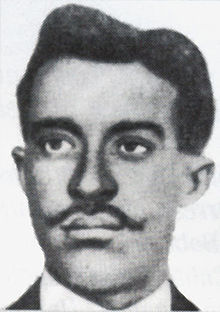Charlemagne Péralte
Charlemagne Péralte | |
|---|---|
 | |
| Birth name | Charlemagne Masséna Péralte |
| Born | October 10, 1886 Hinche, Republic of Haiti |
| Died | November 1, 1919 (aged 33) Near Grande-Rivière-du-Nord, United States occupation of Haiti |
| Buried | |
| Allegiance | Republic of Haiti (before 1915) Cacos (after 1915) |
| Years of service | 1904–1919 |
| Battles/wars | United States occupation of Haiti |
Charlemagne Masséna Péralte (10 October 1886 – 1 November 1919) was a Haitian nationalist leader who opposed the United States occupation of Haiti in 1915. Leading guerrilla fighters called the Cacos, he posed such a challenge to the US forces in Haiti that the occupying forces had to upgrade their presence in the country;[1]: 213 he was eventually killed by American troops. Where he was symbolically crucified, Péralte remains a highly praised hero in Haiti.[2]
Early life
Péralte was born on 10 October 1886 in the city of Hinche. His father was General Remi Massena Peralte. His sister was the second wife of President of Haiti Oreste Zamor.
Guerrilla resistance
An officer by career, Charlemagne Péralte was the military chief of the city of
Refusing to surrender to foreign troops without fighting, Péralte resigned from his position and returned to his native town of
The troops led by Péralte were called "Cacos", a name that harked back to rural troops that historically took part in the political turmoil of late 19th century Haiti. The guerrilla warriors of the Cacos were such strong adversaries that the United States upgraded the US Marine contingent in Haiti and even employed airplanes for counter-guerrilla warfare.[1]: 213 His forces attacked Port-au-Prince in 1919, but were driven off.
Death and aftermath

After two years of guerrilla warfare, leading Péralte to declare a provisional government in the north of Haiti, Charlemagne Péralte was betrayed by one of his officers, Jean-Baptiste Conzé, who led disguised US Marines Sergeant Herman H. Hanneken (later meritoriously promoted to Second Lieutenant for his exploits) and Corporal William Button into the rebels camp, near Grande-Rivière-du-Nord.[1]: 215–217
Péralte was shot at close range.[1]: 217 Hanneken and his men then fled with Peralte's body strapped onto a mule.[1]: 218
In order to discourage rebel support from the Haitian population, the US troops took a picture of Charlemagne Péralte's body tied to a door, and distributed it in the country.[1]: 218 However, it had the opposite effect, with the image's resemblance to a crucifixion making it an icon of the resistance and establishing Péralte as a martyr.[4]
Charlemagne Péralte's remains were unearthed after the end of the US occupation in 1935. A national funeral, attended by the then-President of Haiti, Sténio Vincent, was held in Cap-Haïtien, where his grave can still be seen today.
A portrait of Charlemagne Péralte can now be seen on the Haitian coins issued by the government of Jean-Bertrand Aristide after his 1994 return under the protection of US troops.
Consequently, for their daring exploit, Corporal Button (1895–1921) and Sergeant Hanneken (1893–1986) were both awarded the
References
- ^ ISBN 0025882104
- ^ "Péralte, Charlemagne Masséna (1886–1919) | Encyclopedia.com". www.encyclopedia.com. Retrieved 2024-02-21.
- ISBN 978-1-9788-1541-4.
- ^ "An Iconic Image of Haitian Liberty". The New Yorker. 28 July 2015. Retrieved 6 January 2017.
- ^ "Charlemagne Péralte and the First American Occupation of Haiti 0787219843, 9780787219840". dokumen.pub. Retrieved 2024-02-21.
